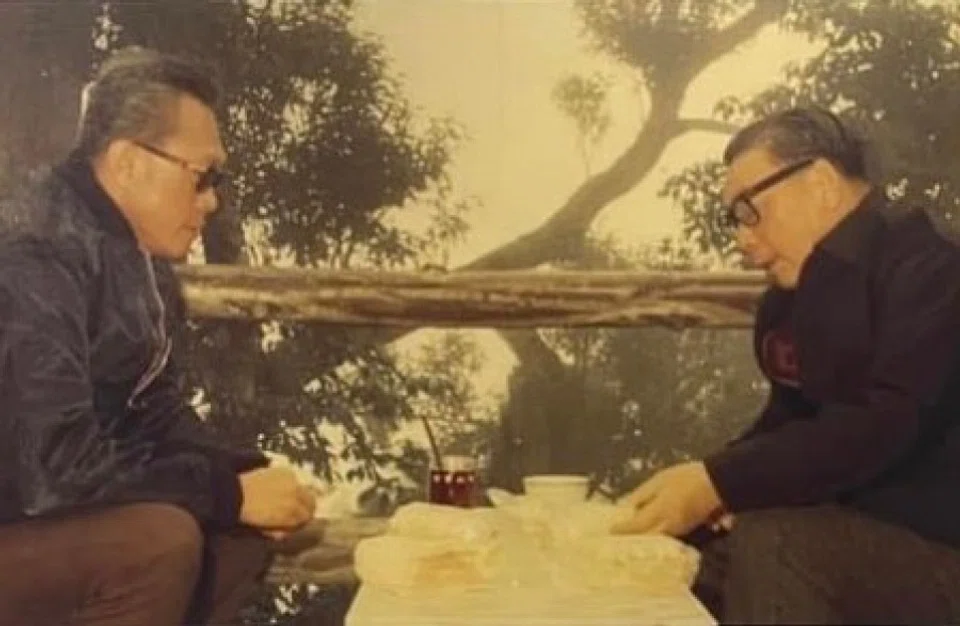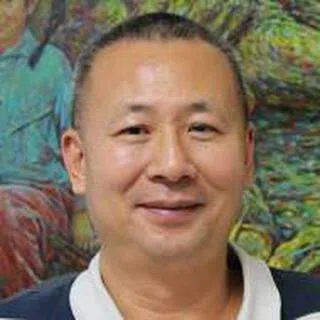[Photo story] Lee Kuan Yew and Chiang Ching-kuo
In Singapore's early days of independence, it had few diplomatic options. However, then Singapore Prime Minister Lee Kuan Yew found an unlikely ally in Taiwan President Chiang Ching-kuo, as the two struck up a friendship that placed them in good stead in more ways than one. Historical photo collector Hsu Chung-mao provides some valuable photographs of the two leaders.

(Photos courtesy of Hsu Chung-mao unless otherwise stated.)
In mid-September this year, Singapore's former Foreign Minister George Yeo visited Taiwan and delivered a speech on cross-strait peace, which caused quite a stir.
I had accompanied Yeo during this trip, which was in the works for more than a year. His visit to Taiwan has been extensively covered by the media in both Taiwan and Singapore, so I need not go into it again. However, there was a small incident that left a deep impression on me.
Lee Kuan Yew also visited these places in Taiwan. He was not just any tourist - Chiang Ching-kuo took him to the mountains, coastlines and outlying islands of Taiwan.
An open secret built on friendship
During the visit, Yeo met Chiang Ching-kuo Foundation chairman and former Taiwanese Foreign Minister Fredrick Chien, who shared that he once represented Taiwanese President Chiang Ching-kuo on a visit to meet Prime Minister Lee Kuan Yew in Singapore to convey some personal matters. They remembered Lee and Chiang's personal connection, which touched on both major historical issues and clandestine diplomatic matters during the formative years of Singapore.
In 1993, I interviewed then Senior Minister Lee. I asked him about Project Starlight, wherein Singapore soldiers trained in Taiwan. This was an open secret, and Lee had few qualms in thanking Taiwan for extending a helping hand during Singapore's most challenging period.
In fact, the key figure behind Project Starlight was Chiang Ching-kuo. This key military project was set up and proceeded smoothly primarily due to the personal friendship and firm trust between Lee and Chiang.
The exhibition hall in the Chiang Ching-kuo Foundation features several interesting historical photos of Lee and Chiang visiting Taiwan and Kinmen. These places are well known to us Taiwanese, and so these photos evoke a strong sense of familiarity.
One would not expect that Lee Kuan Yew also visited these places in Taiwan. He was not just any tourist - Chiang Ching-kuo took him to the mountains, coastlines and outlying islands of Taiwan. Besides building that personal connection, Lee must have developed a profound affection for the island he set foot on.




When the Republic of Singapore was established in 1965, its survival was full of uncertainties. Its neighbours were sceptical; Indonesia under Sukarno adopted a particularly strong foreign policy. The British military in Singapore confirmed its withdrawal in 1968, and Lee Kuan Yew was adamant against having the US military replace them, ruling out the possibility of the US military assisting in Singapore's defence.
The problem was that self-defence could not be delayed for independent Singapore. Even with conscription, it was not possible to establish a skilled and combat-ready air force in the short term. Besides, Singapore was too small to hold long-distance training marches for field units, while long-range artillery exercises were not feasible, as it called for a larger training ground with mountain and jungle terrain.
Lee Kuan Yew approached several countries but was rebuffed as they were unwilling to offend other nations. Eventually, he spoke with Taiwan - surprisingly, both sides quickly reached a consensus for cooperation, and the key figure on the Taiwan side was then Minister of Defense Chiang Ching-kuo.
Deep understanding of the Communist Party
Lee and Chiang had very different educational backgrounds, with seemingly few similarities. However, on closer observation, they actually shared much in common in their thinking.
Chiang went to study in the Soviet Union at the age of 15. He studied military affairs at the Moscow Sun Yat-sen University - a Soviet Red Army school - worked as a labourer in a remote factory in the mountains, and eventually married a Russian woman before returning to China. He witnessed the years of Stalin's purges after the Soviet Revolution until the 1930s.
It can be said that Chiang's thinking and political training and style were deeply influenced by the Communist Party, including his subsequent focus on intelligence, organisation, propaganda, direct dialogue with the masses, understanding their needs, and solving their immediate problems. Chiang's political style was essentially the Communist Party's grassroots work, which he used as a means to counter communism.





Because he understood the Communist Party too well, Chiang became its formidable opponent. He believed that the past failures of the Kuomintang (KMT) in mainland China were actually failures of ideology, organisation and propaganda, leading to lax discipline within the KMT and severe infiltration by the Communist Party - which knew the KMT's every move - resulting in its military failures.
After the KMT retreated to Taiwan, Chiang directly controlled intelligence units, prioritised internal security work for the military, and organised youth efforts, making the youth a crucial force supporting the KMT.
Lee Kuan Yew and Chiang Ching-kuo actually shared many similarities in their political styles, as both were adept at connecting with the masses and addressing their concerns. Inevitably, they were able to see eye to eye...
Similar political styles
Meanwhile, Lee Kuan Yew went through the difficult years of Japanese rule during World War II and narrowly escaped death at the hands of the Japanese troops. After the war, Lee pursued his studies in England, and returned to Singapore amid a wave of anti-colonial and independence movements in Southeast Asia.
Lee started off as a lawyer defending anti-colonial activists. Later, he and some like-minded friends formed the People's Action Party (PAP), opposing British colonial rule. Singapore subsequently achieved self-governance, then merged with Malaya to form Malaysia. Singapore eventually separated from Malaysia to become an independent republic.





Throughout this tumultuous history, the main threats to Singapore were primarily racism and communism. Even after the departure of left-wing forces, the PAP - originally a coalition of two anti-colonial forces - still had ideological and organisational connections with the armed forces of the Malayan Communist Party in the jungle, and so Singapore still faced the danger of communist infiltration and subversion.
Following years of political struggle, Lee became intimately familiar with the organisational structure of the Communist Party and the political tactic of mobilising the masses. He was himself a charismatic political leader with organisational skills.
Lee Kuan Yew and Chiang Ching-kuo actually shared many similarities in their political styles, as both were adept at connecting with the masses and addressing their concerns. Inevitably, they were able to see eye to eye - each understood what the other was facing.
He would bring Lee to all corners of Taiwan, and a deep friendship naturally formed between them.
Highest respect and gratitude
Chiang had a unique background in terms of military exchanges and cooperation. At the time, Taiwan had formal diplomatic relations with the US, which had a military presence in Taiwan. Chiang resisted US attempts to control Taiwan, leading to US accusations that he orchestrated the May 24 incident (also called the Liu Ziran incident or Reynolds riot) - the incident involved anti-US protests following the killing of Taiwanese researcher Liu Ziran by US soldier Robert Reynolds.
However, Chiang also engaged in close military cooperation with the US. The most important item was the establishment of an intelligence station in Taiwan by the Central Intelligence Agency. KMT Air Force pilots were deployed to fly US U-2 high-altitude reconnaissance planes into mainland China's inland areas.


The handling of Taiwan's military cooperation was personally led by Chiang, and so he had full oversight and control to privately decide on military cooperation with Singapore. So, when Chiang became Taiwan's leader after 1970, there were no obstacles to cooperation.
According to information, Lee would visit Taiwan almost every year, for work and to meet old friends. Meanwhile, Chiang enjoyed visiting the various parts of Taiwan, getting to know the local people. He would bring Lee to all corners of Taiwan, and a deep friendship naturally formed between them.
Chiang passed away in early 1988, and Lee led a group of key Cabinet members to attend Chiang's funeral in Taiwan. It was not simply a farewell between good friends...



When we visited Fredrick Chien, he shared that he was sent by Chiang to Singapore just to explain to Lee that Chiang was getting increasingly frail and unable to host old friends. Chien said, "When Lee heard about Chiang's rapid decline in health, he appeared solemn and teary-eyed."
Chiang passed away in early 1988, and Lee led a group of key Cabinet members to attend Chiang's funeral in Taiwan. It was not simply a farewell between good friends - the presence of Singapore's ministers also expressed the highest respect and gratitude to a friend who had made significant contributions to the founding of Singapore.



Indelible foundation for today's achievements
In his speech, George Yeo also specifically mentioned the relationship between President Lee Teng-hui and Singapore after Chiang passed. At that time, Yeo had already entered government service and personally witnessed some of these events.
In 1994, in an interview with Japanese writer Ryotaro Shiba, Lee Teng-hui affirmed Japanese colonialism and described himself akin to Moses leading the people out of Egypt. Lee Kuan Yew immediately sensed that the situation in Taiwan had changed. Indeed, the unfettered personal-level exchanges between the top leaders of both sides gradually became a thing of the past.


Today, the international situation has moved beyond the Cold War era. Ideological opposition is gone, new issues have emerged, and world peace calls for new thinking and action. It is indeed a new mission for the next generation of national leaders.
Nevertheless, the friendship and effort that once was, has laid an indelible foundation for today's achievements. It is not only worthy of being put on record, but also deserving of renewed awareness and due thought.



![[Photos] Fact versus fiction: The portrayal of WWII anti-Japanese martyrs in Taiwan](https://cassette.sphdigital.com.sg/image/thinkchina/3494f8bd481870f7c65b881fd21a3fd733f573f23232376e39c532a2c7593cbc)

